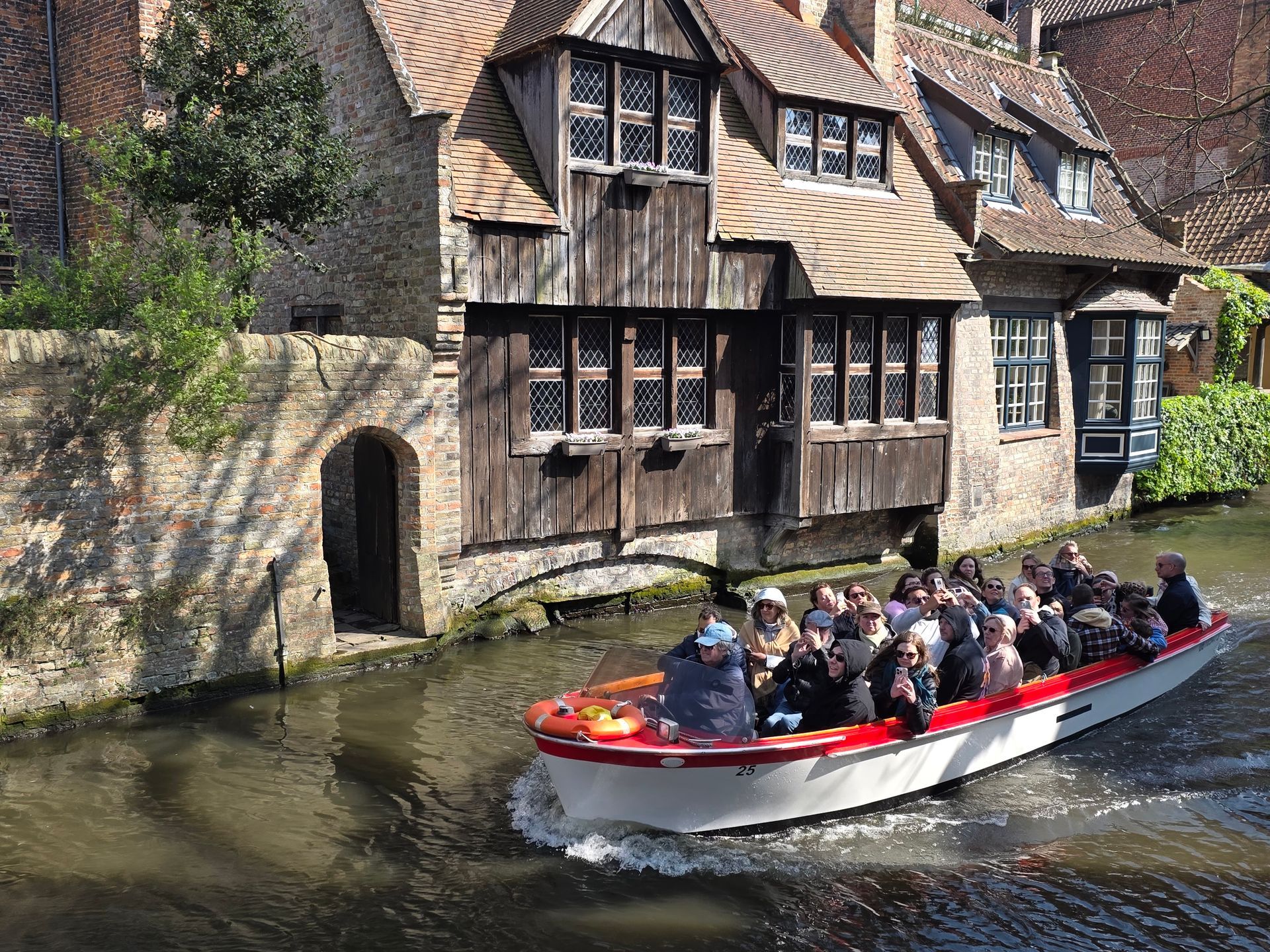Bruges’ Rare Wooden Houses
Ann Vandermeeren • 12 augustus 2025
Stepping Back into the City’s Medieval Heart
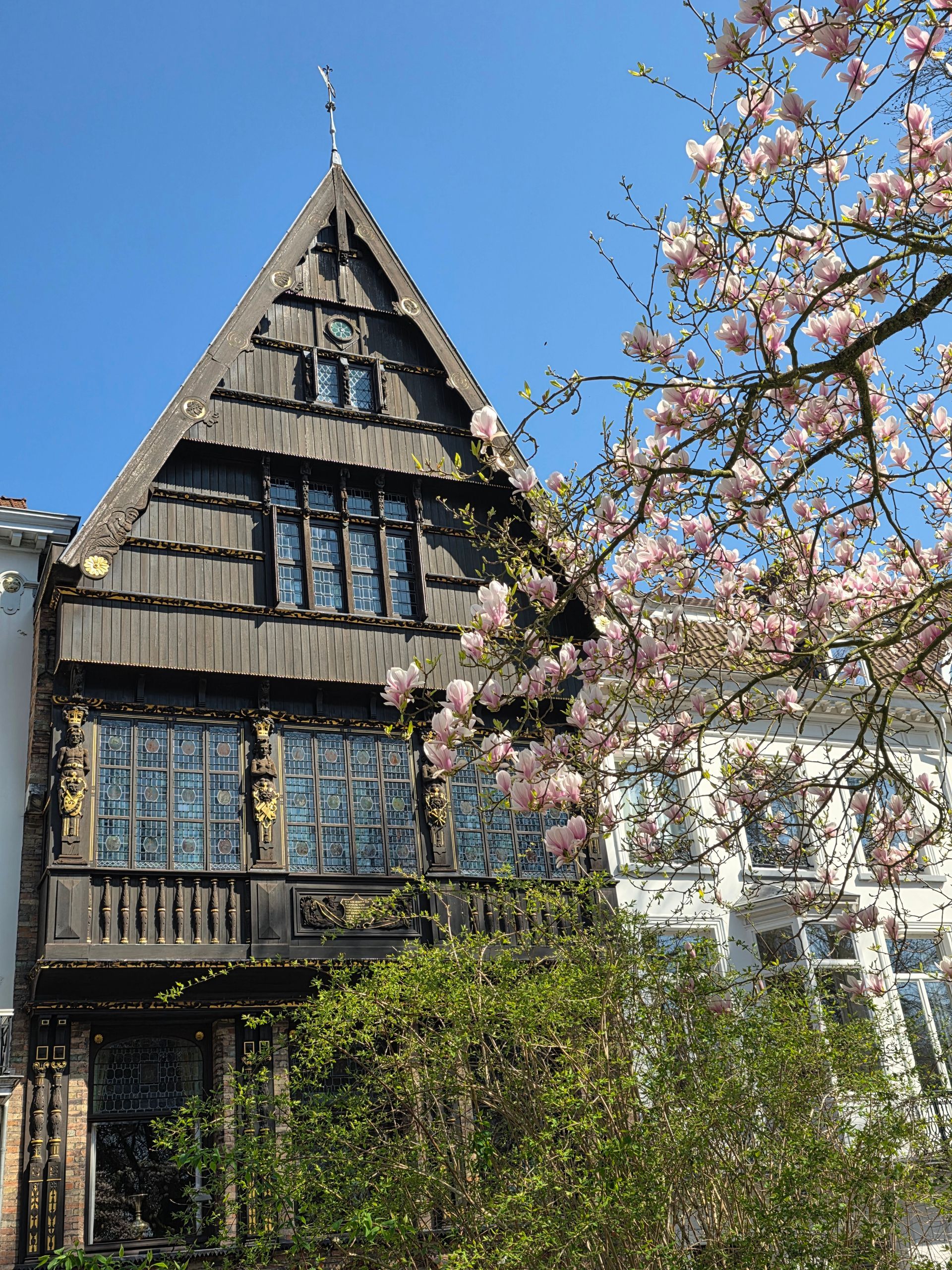
While Bruges is world-famous for its Gothic stone façades and winding canals, a few rare gems stand out in warm, weathered timber — echoes of a time before building laws forever changed the city’s skyline. These wooden houses, survivors from centuries past, offer visitors a glimpse into medieval craftsmanship and the intimate scale of old Bruges.
The “Lucas-Huys” – A Neorenaissance Treasure with a Traveling Past
One of the most intriguing examples stands at Hertogstraat 22, known as the Lucas-Huys. This three-bay, three-storey house under a Flemish-tile gable roof dates from 1889 but carries a story that spans cities and centuries.
Originally built in Brussels in 1875 by architect A. Mennessier, its elaborate Neorenaissance façade was moved to Bruges in 1889–1890 under the guidance of Bruges architect L. Delacenserie. Only the ornate gable top is fully original; the rest was partly rebuilt to harmonize with its new location.
The façade is a delight for detail-lovers: carved wooden beams, floral wrought-ironwork, a round-arched doorway, and a central stone dated “1573.” On the upper floors, broad windows are framed by sculpted herms, with decorative panels and inscriptions, including a whimsical 17th-century proverb in old Dutch. Look closely at the stained-glass windows — they illustrate sayings by the famous Dutch poet Jacob Cats.
Inside, the house is furnished in Flemish Renaissance style, complete with an oak staircase rescued from Bruges’ former St. Nicholas Hospital. It’s a living example of Bruges’ 19th-century love for historical restoration.
Relais Bourgondisch Cruyce – The Most Photographed Façade in Bruges
Few hotels in the world can claim to be a landmark in themselves, but Relais Bourgondisch Cruyce, right on the Dijver, certainly can. Its half-timbered façade, leaded windows, and flower-filled balconies appear in thousands of tourist photos — and even in the Hollywood film In Bruges.
From its terrace, you can sip coffee while swans glide past and canal boats drift under the nearby stone bridge. Across the water, you’ll see the City Hall and the Basilica of the Holy Blood; a short walk away lies the iconic Rozenhoedkaai, one of Bruges’ most photographed spots.
The building’s history reaches back to around 1680, when it housed a wealthy lace-trading family. Goods were once loaded directly onto boats through doors at water level. After a devastating fire in 1902, the house was rebuilt and later merged into the charming luxury hotel you see today.
Hidden Survivors – Genthof and Kortewinkel
Beyond these famous façades, Bruges hides two authentic medieval wooden houses in Genthof and Kortewinkel. Their survival is remarkable: each upper storey projects slightly further out than the one below, a medieval trick to gain space and protect the walls from rainwater.
As early as the 13th century, the city issued rules to limit fire hazards from timber construction, and by the 17th century, wooden façades were officially banned. Hundreds vanished over time, making these few survivors all the more precious.
Visiting Tips
Hertogstraat 22 (Lucas-Huys) can be admired from the street; bring a zoom lens to capture the intricate carvings and stained glass.
Relais Bourgondisch Cruyce is best enjoyed over coffee or tea on the canal-side terrace — arrive early to secure a table with a water view.
Genthof and Kortewinkel are short walks from the Markt; combine them with a stroll along nearby canals for the full medieval atmosphere.
Near Bonifaciusbridge you will find Guesthouse Bonifacius. Amazing!
For photography, aim for morning or late afternoon when the light brings out the warm tones of the timber.
These rare wooden houses are not just architectural curiosities — they are living reminders of a Bruges that once bristled with gabled timber façades, a softer, more intimate counterpoint to its grand stone monuments. Seeing them in person is like catching a fleeting glimpse of the city’s earliest centuries, still standing strong against the tides of time.
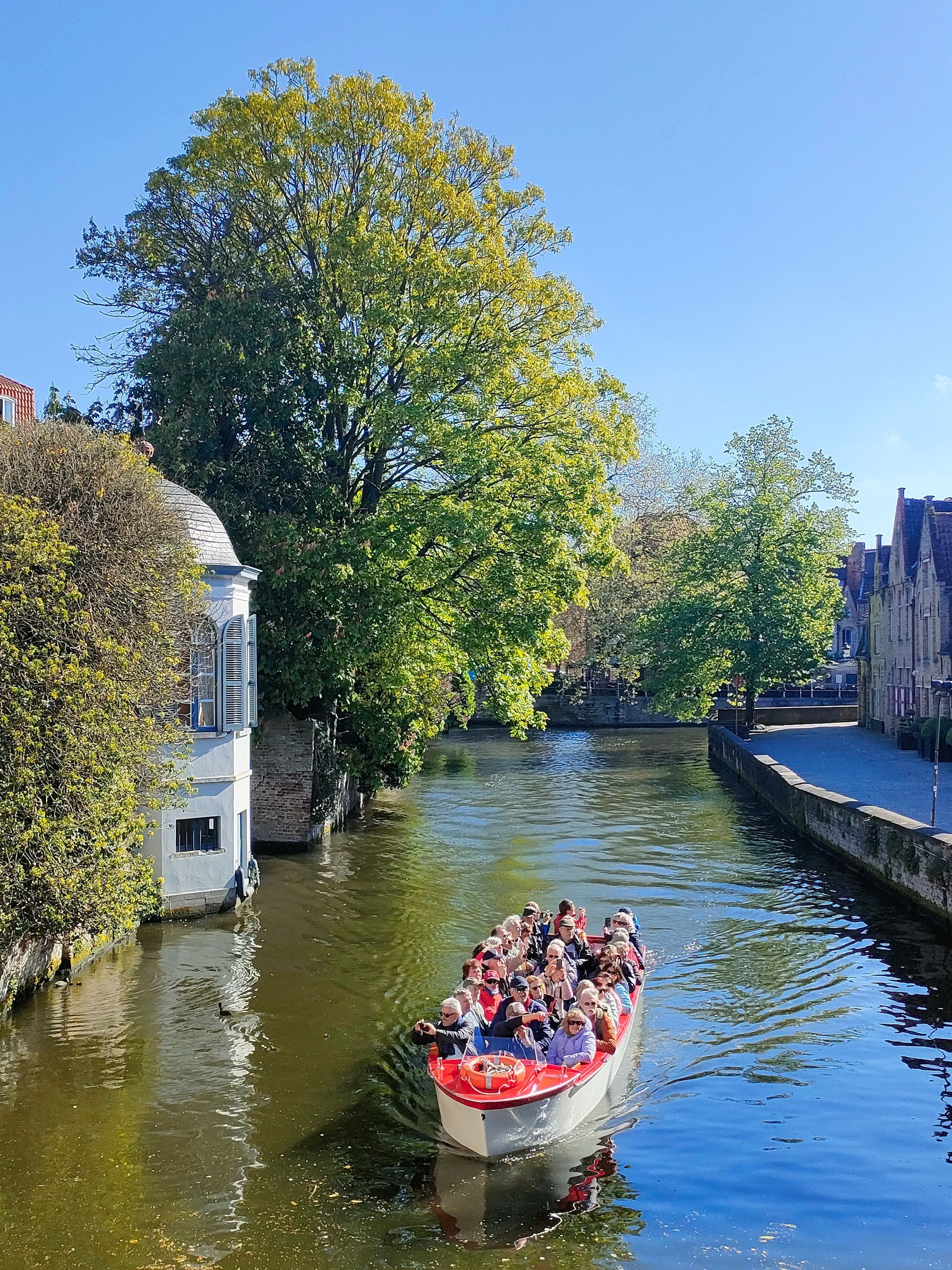
Bruges is famous for its charming canals—each one a little gem—but none quite as enchanting as the Groenerei. This peaceful stretch of water, lined with a stunning skyline and plenty of greenery, is without a doubt one of the most picturesque spots in the city. Romantic bridges arch over the water here and there, making it the perfect place for a leisurely stroll or simply to sit back and soak up the tranquil atmosphere. Where is the Groenerei? The Groenerei is both a canal and a street located in the heart of Bruges. The canal flows from the Kraanrei near the Huidenvettersplein all the way to where it meets the Sint-Annarei and the Coupure, close to the Molenbrug (Mill Bridge). Along the southern bank, the street named Groenerei runs from the Predikherenbrug to the Meebrug, while the western section of this southern bank street is called Steenhouwersdijk—a name it bore entirely until around 1825. Several charming bridges cross the Groenerei, including the Peerdenbrug (dating back to 1642), the Meebrug, and the Blinde-Ezelbrug, each adding its own historic charm to the scene. History and Name The name "Groenerei" likely comes from an old inn called ‘t Groene, and many longtime Bruges residents still refer to the canal by that name. For centuries, the street now called Steenhouwersdijk was also known as Groenerei. For a long time, it was believed the Groenerei was a man-made canal dug before the 11th century to supply water to a mill near the Molenbrug. Recent studies suggest it is actually part of the natural course of the Reie river, making it an original waterway that became part of Bruges’ first city walls around 1127. Highlights Along the Groenerei One remarkable landmark on the Groenerei is the Godshuis De Pelikaan, a historic almshouse with a unique story. Nearby once stood the buildings of the famous Daveluy printing press (1841–1909), later home to the editorial office and printing of the liberal newspaper Journal de Bruges until 1953. The Experience Today Starting from the Old Fish Market (Vismarkt) and heading towards the Predikherenrei, you’ll find a vibrant stretch where cozy cafés and restaurants invite you to stop for a bite or a drink. Whether you choose to stroll the canal’s peaceful banks or settle on a bench to enjoy the water’s gentle flow, the Groenerei is a place to unwind and take in the quintessential beauty of Bruges. With its perfectly framed skyline, lush greenery, and romantic bridges, the Groenerei and its surroundings were recognized as Bruges’ fifteenth protected cityscape. This status honors not only the area’s exceptional charm but also the dedication of local residents and property owners who work tirelessly to preserve and enhance this beautiful urban landscape. Practical tip: For the best experience, start your walk at the Old Fish Market, meander along the canal towards the Predikherenrei, and stop at one of the many inviting restaurants or cafés along the way for a true taste of Bruges’ hospitality.
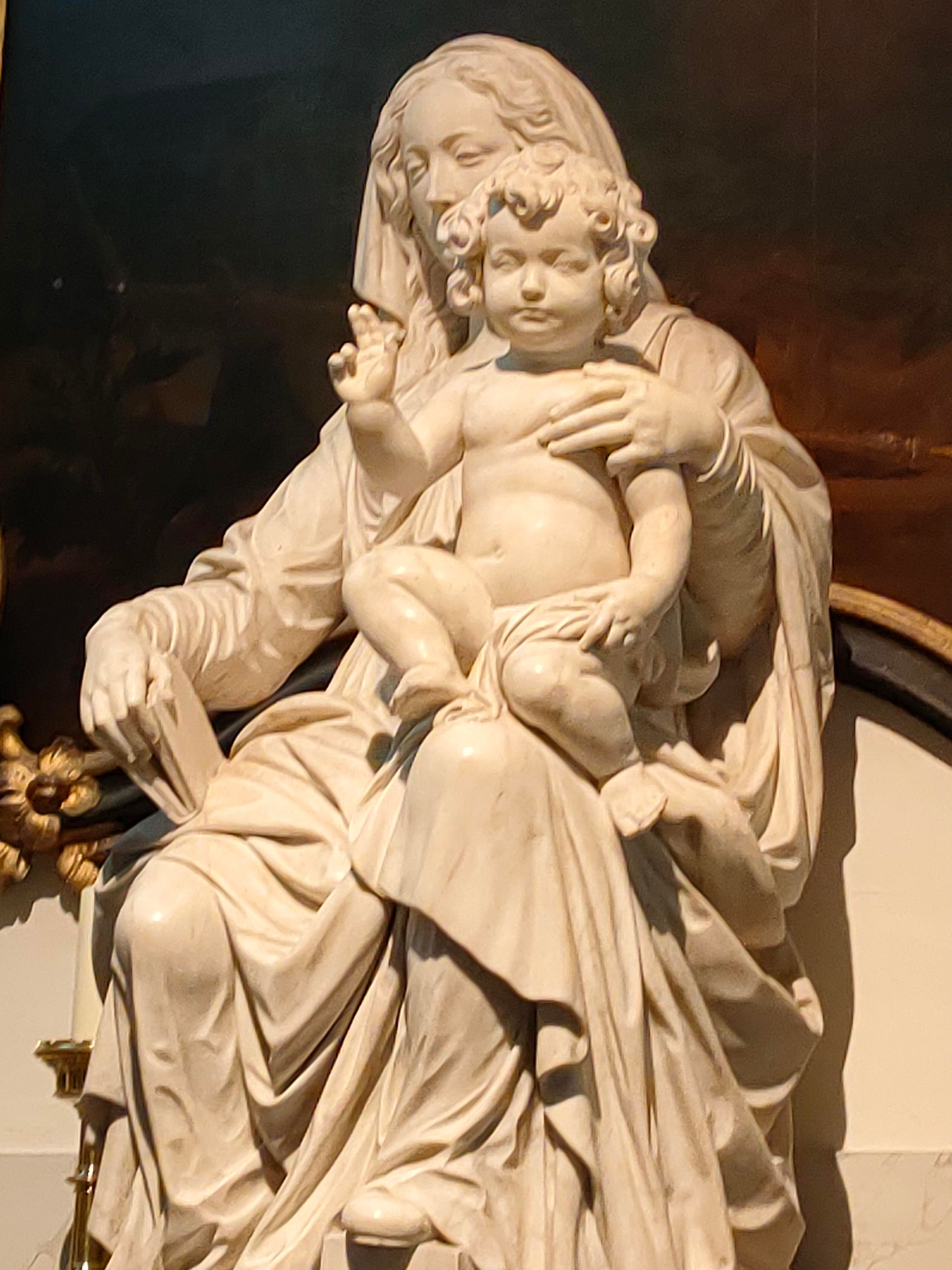
In the Church of Our Lady in Bruges, you’ll find a true treasure: the Madonna and Child, also known as the Bruges Madonna. This stunning marble sculpture was created by none other than Michelangelo between 1501 and 1504, shortly after he completed his famous Pietà. It’s likely the only Michelangelo sculpture that left Italy during his lifetime. What makes this sculpture so special? Life-sized and impressive: Standing 128 cm tall and weighing nearly 750 kilograms, this white Carrara marble statue radiates serene power. Unique portrayal: Unlike traditional depictions where Mary lovingly holds the child, here the Christ child stands almost independently, ready to face the world. Mary gazes downward with a sorrowful look, aware of her son’s destined suffering. Style and symbolism: The sculpture blends Byzantine icon influences with Italian Renaissance styles. Small details—like the book Mary holds, gently pressed by the child’s hand—symbolize Christ’s passion. The fascinating history of the Bruges Madonna In 1506, the sculpture was purchased for 100 gold ducats by Jan Mouscron, a wealthy Bruges cloth merchant. It was shipped via Lucca to Bruges and donated to the Church of Our Lady in 1514. The statue forms part of the Mouscron altar, which represents faith, hope, and charity combined with the theme of the Eucharist. Even the famous artist Albrecht Dürer admired the sculpture during his visit to Bruges in 1521. Visiting tips Where to see it? The Madonna is housed in the Church of Our Lady, one of Europe’s finest Gothic churches, right in the heart of Bruges. Admission: The church itself is free to enter, but there is a small fee for the museum section that includes the altar. Accessibility: The museum offers a 3D-printed tactile model and a touch station, allowing visually impaired visitors to experience the artwork through touch. Make it a full day: Combine your visit with the nearby Gruuthuse Museum, which also emphasizes accessibility and displays remarkable art collections. Why you should see it The Bruges Madonna is not only an art historical masterpiece but also a tangible link to the rich history of Bruges and Michelangelo’s genius. Whether you’re an art lover or simply curious about the city’s hidden stories, this sculpture is sure to captivate you.
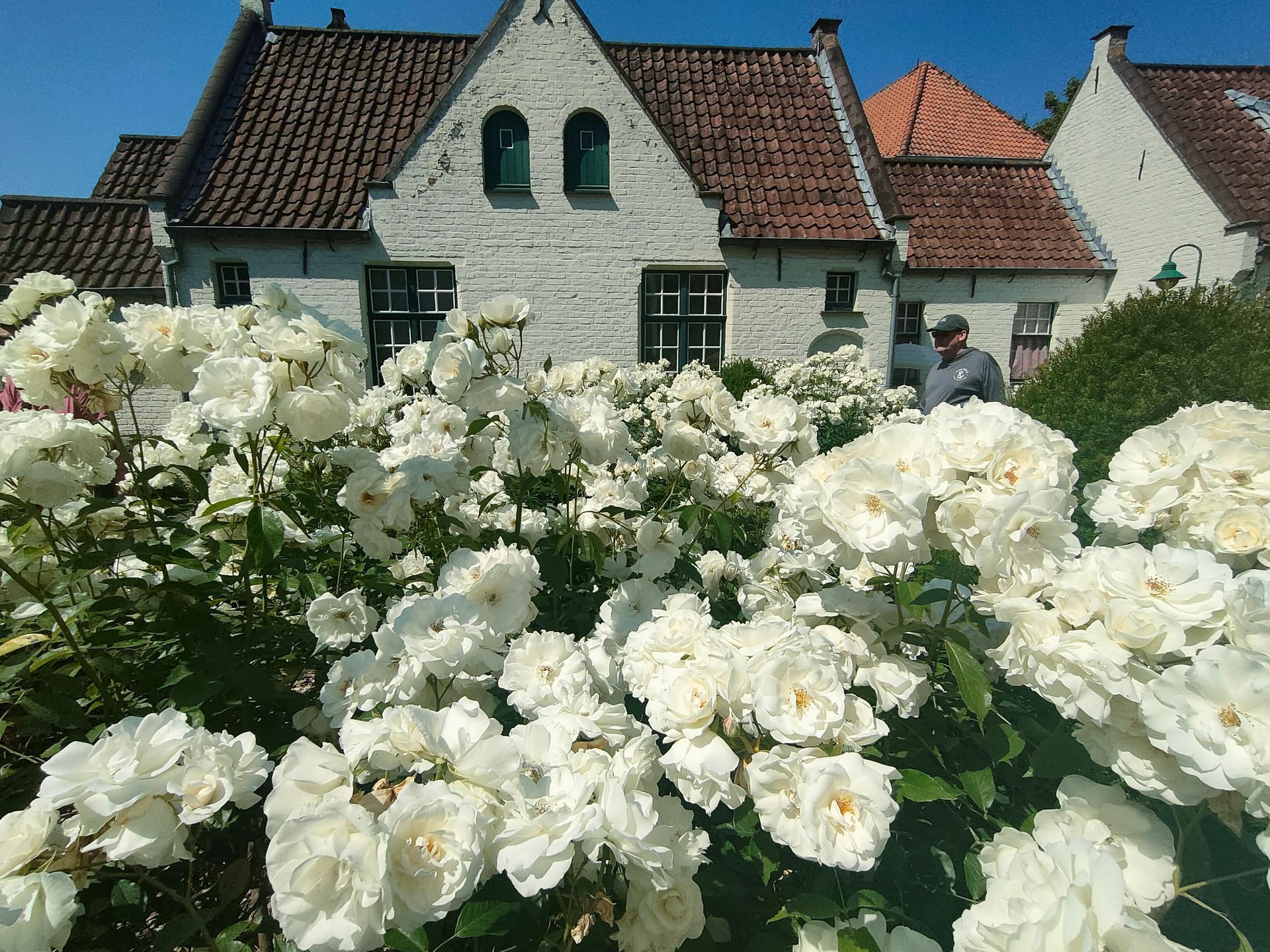
Often called the “quiet Bruges,” the Sint-Anna district in the eastern part of the city may seem peaceful, but don’t be fooled — there’s plenty to discover here. This medieval working-class neighborhood is a lesser-known part of Bruges, yet it holds a wealth of history, culture, and beautiful sights. From authentic windmills and traditional workers’ houses to exclusive gentlemen’s clubs, Sint-Anna offers a fascinating glimpse into the city’s past and present. Behind high walls lie stunning estates, religious heritage sites, and inviting neighborhood parks that provide calm escapes from the bustling city center. Follow the Jeruzalemstraat to the right and you’ll arrive at the Adornes Domain, easily recognizable by its distinctive Eastern-style tower. This private estate, including the unique Jerusalem Chapel, is open to visitors for a small fee (€10) and is well worth a visit. The Balstraat is home to the Lace Center and the Folklore Museum, both celebrating local traditions and crafts. Back in the 16th century, there were around thirty windmills along the city’s moat, but only four remain today. Be sure to climb the mound near the second mill, the Sint-Janshuismolen, for a peek into the garden of the Sint-Sebastiaansgilde — a guild with a 600-year history and royal patrons among its honorary members. Nearby, you’ll also find the beautiful Elisabeth Zorghe almshouse — a peaceful and picturesque sanctuary surrounded by charming façades and well-tended front gardens. It perfectly reflects the quiet charm of the neighborhood. If you need a break during your exploration, stop by De Verloren Hoek, a cozy local café offering a warm welcome and a chance to relax in true Bruges style. Religious Heritage: Sint-Annakerk & Jeruzalemkapel The simple yet striking Gothic hall church of Sint-Annakerk, built in the early 17th century, surprises visitors with its rich Baroque interior. Thanks to generous donations from wealthy Bruges citizens, you can admire its marble rood screen, oak paneling with built-in confessionals, paintings by Jan Garemijn, and the largest painting in Bruges. The Jerusalem Chapel reflects the deep devotion of the Adornes family to the Holy City. Inside, you’ll find fascinating artifacts, including: The tomb monument of Anselm Adornes and Margaretha van der Banck, crafted by Cornelis Tielman. Anselm was murdered in Scotland, where he is also buried; only his heart was brought here to rest forever beside his wife. The Golgotha altarpiece, an impressive limestone sculpture depicting Golgotha, the hill where Christ was crucified. Some of Bruges’ oldest stained glass windows, created around 1560, telling the remarkable story of the Adornes family through a vivid play of light and color. Why Visit Sint-Anna? Sint-Anna offers a rare blend of history, culture, and tranquility. Its picturesque streets, peaceful canals, and beautifully maintained homes invite you to slow down and soak in the quiet charm. Whether you’re wandering along the canals, exploring ancient mills, stepping inside sacred chapels, or enjoying a relaxing pause at a local café, this neighborhood is a delightful escape and a richly textured side of Bruges that many visitors overlook.
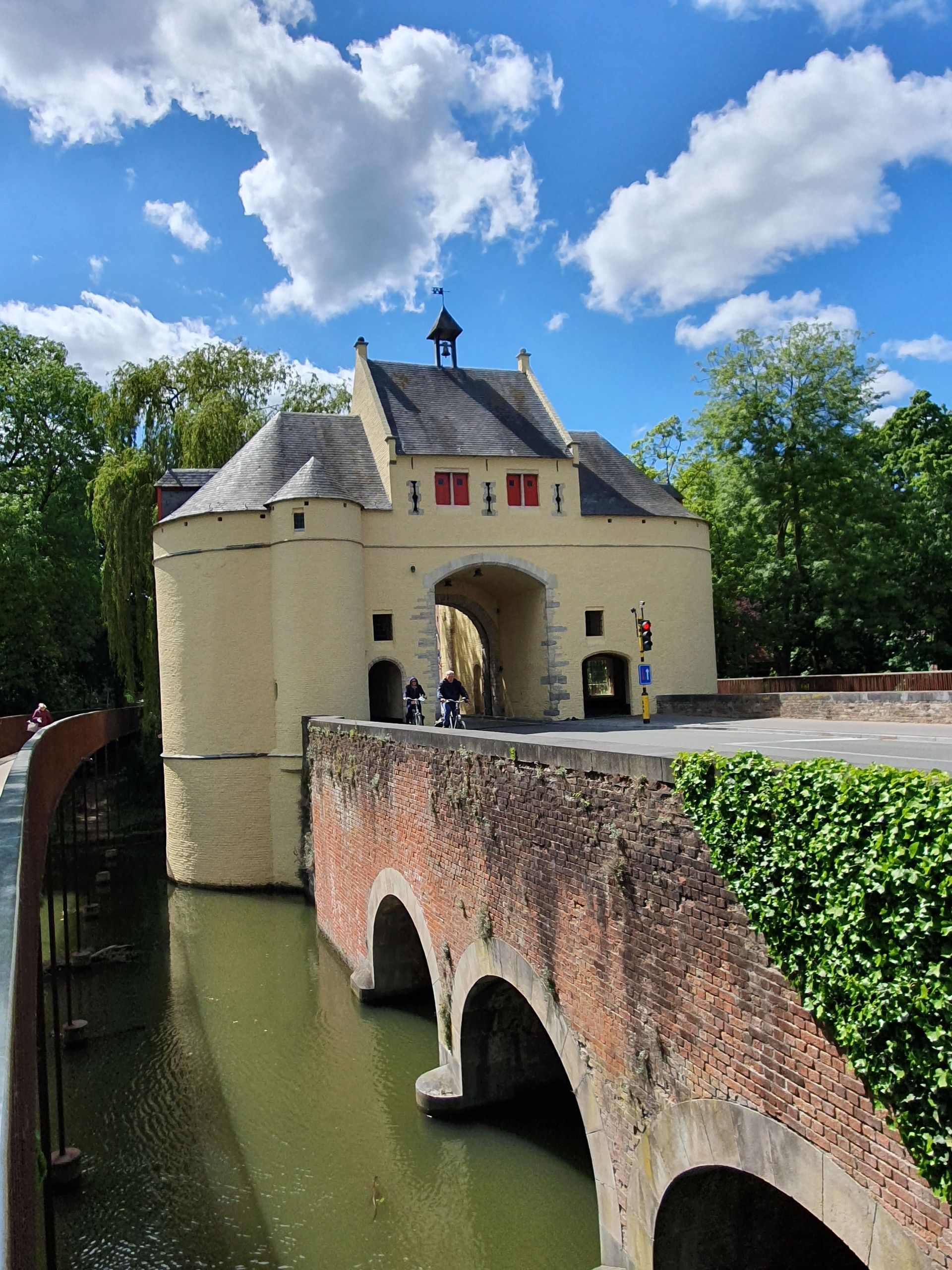
Bruges has well-preserved city walls. Among its historic features, the four ancient city gates and the surrounding vesten (moats and ramparts) stand out as remarkable reminders of Bruges’ rich past. For visitors seeking a unique way to explore the city, walking along the path that traces the old city walls offers both a scenic and historic experience. The Four City Gates of Bruges Bruges was once a fortified city, surrounded by thick stone walls and protected by four main gates. These gates served as entry points, controlling trade and defending the city from invaders. Each gate has its own distinct history and charm: Gentpoort (Ghent Gate) The Gentpoort is one of Bruges’ four preserved medieval city gates. For outsiders, it was the entrance to the city; for locals, it marked the boundary to the outside world. The gate not only defended the city but also served as a passageway for goods entering and leaving Bruges. Above the archway, in a niche, stands a statue of Saint Adrian, believed to protect Bruges from the plague. Today, the Gentpoort houses the office of the city guides, making it a lively spot connecting history with the present. Smedenpoort (Smiths’ Gate) The first Smedenpoort dates back to 1297–1299. The current structure was built on its remains in 1367 and has undergone many changes over the centuries. A notable feature is the bronze skull above the left arch, which serves as a grim reminder of François Vander Straeten, who was executed at the end of the 17th century for attempting to let hostile French troops into the city. His severed head was displayed here for a long time as a warning. Kruispoort (Cross Gate) The original Kruispoort was constructed during the second city wall expansion between 1297 and 1304 but was replaced in 1366. The gate was destroyed in 1382 when Philip van Artevelde and the citizens of Ghent seized the city. The current gate dates from 1400. Only its two massive towers with a narrow passage and two octagonal turrets have been preserved. Since the late 20th century, it has housed the Sint-Michielsgilde, a Bruges-based association of fencing practitioners. Ezelspoort (Donkey Gate) The Ezelspoort, located in the northern part of the city, is quieter and less visited but no less significant. Since 2010, the gate has been home to the administration of Anima Eterna Brugge, a renowned local music ensemble. The peaceful surroundings and nearby canals make it a charming spot to explore. The Vesten: Bruges’ City Walls and Moats Surrounding Bruges is a system of moats and ramparts known as the vesten. These water-filled moats were once crucial for the city’s defense, making it difficult for enemies to breach the walls. Today, the vesten form a beautiful green belt around the historic center, perfect for walking, jogging, or simply enjoying nature. The vesten’s calm waters reflect the medieval towers and bridges, creating picturesque views that change with the seasons. Along the way, benches and small parks invite visitors to pause and soak in the atmosphere. Walking the Path Around the City Walls Starting from the Gentpoort, visitors can follow a marked walking path that loops around the city center, tracing the course of the old walls and moats. The entire route covers approximately 5 kilometers (3 miles) and is mostly flat, making it accessible for most walkers. The walk takes you through a mix of historic sights and serene natural spots. You’ll pass quaint canals, charming footbridges, and stretches of green parks. Along the way, informational plaques tell the stories behind the gates and the city’s defenses, enriching the experience with historical context. This walk is a perfect way to see a side of Bruges that many tourists miss — the quiet, reflective spaces that surround the bustling medieval heart of the city. It’s also a wonderful opportunity to enjoy fresh air, peaceful water views, and photo-worthy landscapes. Whether you’re a history buff or simply looking for a pleasant stroll, exploring Bruges’ four city gates and the vesten on foot offers a memorable blend of culture, nature, and architecture — all wrapped up in the magic of one of Europe’s most beautiful medieval cities.
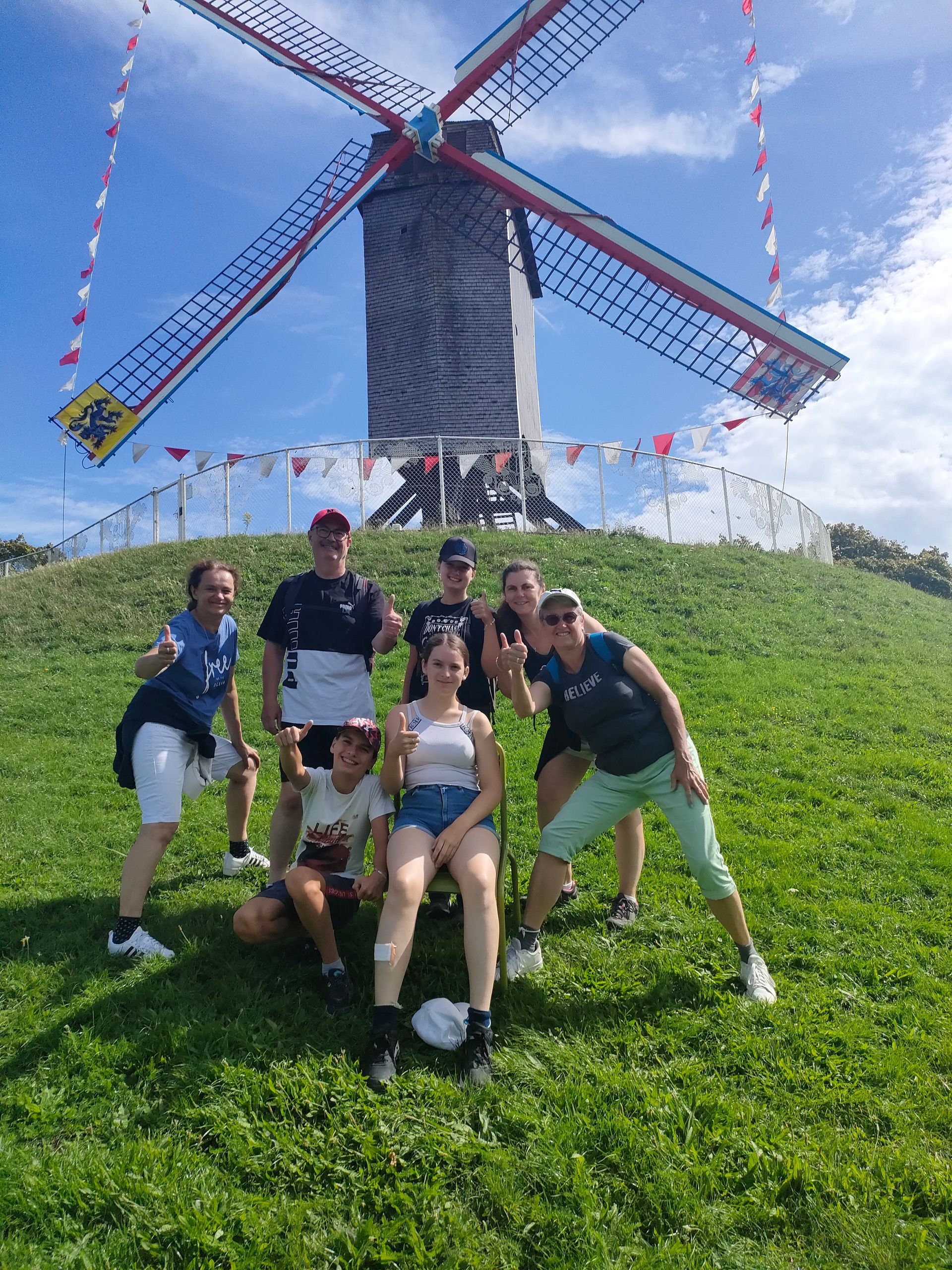
Bruges, often called the “Venice of the North,” is famous for its charming canals, medieval architecture, and rich history — but one of its most iconic yet sometimes overlooked features are its historic windmills. Scattered along the city’s old ramparts, these windmills stand as silent witnesses to Bruges’ past and offer a glimpse into the traditional ways of life. Dating back to the 18th and 19th centuries, the windmills were originally built to grind grain for the local population. Positioned strategically on the city walls, their elevated locations allowed them to catch the steady winds that sweep across the flat Flemish landscape. Today, a few of these mills have been preserved and restored, serving as both cultural landmarks and museums. The most famous among them include the Sint-Janshuismolen, Koeleweimolen, Bonne-Chieremolen, and the recently restored Kruisvestmolen. Visiting these mills not only provides insight into the ingenious engineering of the past but also offers picturesque views of Bruges’ serene canals and rooftops. A stroll along the city’s ramparts will lead you past these charming structures — a perfect blend of history, architecture, and natural beauty. Whether you’re a history buff, photography enthusiast, or simply someone looking to explore beyond the usual tourist path, Bruges’ windmills are a must-see highlight that truly capture the city’s timeless charm.




